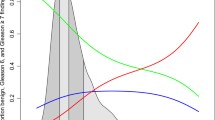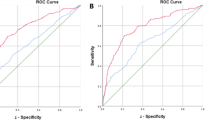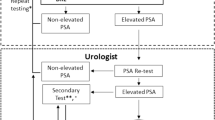Summary
Prostate-specific antigen (PSA) is the most accurate serum marker for cancer of the prostate (CaP). However, its sensitivity and specificity are suboptimal, especially at values ranging between 4.1 and 10.0 ng/ml (monoclonal), because benign prostatic hypertrophy and hyperplasia (BPH) and CaP frequently coexist in this range. This study was undertaken to determine the value of incorporating prostate volume measurements with serum PSA levels in a quotient (PSA/volume) entitled PSA density (PSAD). A total of 3140 patients were analyzed and stratified by serum PSA, digital rectal examination (DRE), transrectal prostate ultrasound (TRUS), TRUS volume determination and PSAD. All patients were referred for evaluation and therefore do not represent a screened population. Patients underwent prostate biopsies when abnormalities in TRUS or DRE were detected. Although both PSA and PSAD have statistical significance when the serum PSA value is ≦4.0 ng/ml, neither has clinical significance in differentiating BPH from CaP. At serum levels ranging between 4.1 and 10.0 ng/ml, PSA has no ability to differentiate BPH from CaP, whereas PSAD does so with statistical and clinical significance. When the PSA value is between 10.1 and 20.0 ng/ml, only PSAD is statistically significant. When PSA exceeds 20 ng/ml, PSAD is redundant. We conclude that all patients with an abnormality on DRE or TRUS should undergo prostate biopsy. If the PSA value is ≦4.0 ng/ml, TRUS and PSAD are not warranted and routine biopsy is not recommended. For intermediate PSA levels, 4.1–10.0 ng/ml, TRUS, TRUS prostate volume, and PSAD are important. The use of PSAD provides unique information regarding the need for biopsy and the likelihood of CaP. At PSA levels ranging between 10.1 and 20.0 ng/ml, PSAD will identify those patients who are less likely to have CaP, but all should undergo biopsy. If the PSA value is >20 ng/ml, all patients should undergo a biopsy.
Similar content being viewed by others
References
Wang MC, Valenzuela LA, Murphy GP, Chu TM (1979) Purification of a human prostate specific antigen. Invest Urol 17:159–163
Wang MC, Papsidero LD, Kuriyama M et al (1981) Prostatic antigen: a new potential marker for prostatic cancer. P Rostate 2:89–96
Babaian RJ, Fritsche HA, Evans RB (1990) Prostate gland volume: correlation and clinical application. J Clin Lab Anal 4:135–137
Guinan P, Bhatti R, Ray P (1987) An evaluation of prostate specific antigen in prostatic cancer. J Urol 137:686–689
Papsidero LD (1983) Monoclonal antibody (F5) to human prostate antigen. Hybridoma 2:139–147
Lange PH, Brawer MK (1989) Serum prostate-specific antigen: its use in diagnosis and management of prostate cancer. Urology 33 [Suppl]:13–17
Stamey TA, Yang N, Hay AR et al (1987) Prostate-specific antigne as a serum marker for adenocarcinoma of the prostate. N Engl J Med 317:909–916
Chan DW, Bruzek DJ, Oesterling JE et al (1987) Prostate specific antigen as a marker for prostatic cancer: a monoclonal and a polyclonal immunoassay compared. Clin Chem 33:1916–1920
Catalona WJ, Smith DS, Ratliff TL et al (1991) Measurement of prostate-specific antigen in serum as a screening test for prostate cancer. N Engl J Med 324:1156–1161
Cooner WH (1991) Prostate-specific antigen, digital rectal examination, and transrectal ultrasonic examination of the prostate in prostate cancer detection. In: Stamey TA (ed) 1991 Monographs in Urology, vol 12, pp 3–13
Cooner WH, Mosley BR, Rutherford CL et al (1990) Prostate cancer detection in a clinical urological practice by ultrasonography, digital rectal examination and prostate specific antigen. J Urol 143:1146–1154
Cooner WH, Mosley BR, Rutherford CL et al (1988) Clinical application of transrectal ultrasonography and prostate specific antigen in the search for prostate cancer. J Urol 139:758–761
Waterhouse RL, Resnick MI (1989) The use of transrectal prostatic ultrasonography in the evaluation of patients with prostatic carcinoma. J Urol 141:233–239
Benson MC, Ring KS, Olsson CA (1989) The determination of stage D-0 carcinoma of the prostate utilizing PSA. Urol Correspondence Club September
Benson MC, Whang IS, Pantuck A et al (1992) Prostate specific antigen density: a means of distinguishing BPH and prostate cancer. J Urol 147:815–816
Benson MC, Whang IS, Olsson CA et al (1992) The use of prostate specific antigen density (PSAD) to enhance the predictive value of intermediate levels of serum PSA. J Urol 147:817–821
Littrup PJ, Williams CR, Egglin TK, Kane RA (1991) Determination of prostate volume with transrectal ultrasound for cancer screening, part II. Radiology 179:49–53
Stamey TA, Kabalin JN (1989) Prostate specific antigen in the diagnosis and treatment of adenocarcinoma of the prostate. I. Untreated patients. J Urol 141:1070–1075
Stamey TA, Kabalin JN, McNeal JE et al (1989) Prostate specific antigen in the diagnosis and treatment of adenocarcinoma of the prostate. II. Radical prostatectomy treated patients. J Urol 141:1076–1083
Stamey TA, Kabalin JN, Ferrari M (1989) Prostate specific antigen in the diagnosis and treatment of adenocarcinoma of the prostate. III. Radiation treated patients. J Urol 141:1084–1087
Stamey TA, Kabalin JN, Ferrari M, Yang N (1989) Prostate specific antigen in the diagnosis and treatment of adenocarcinoma of the prostate. IV. Anti-androgen treated patients. J Urol 141:1088–1090
Author information
Authors and Affiliations
Rights and permissions
About this article
Cite this article
Benson, M.C., McMahon, D.J., Cooner, W.H. et al. An algorithm for prostate cancer detection in a patient population using prostate-specific antigen and prostate-specific antigen density. World J Urol 11, 206–213 (1993). https://doi.org/10.1007/BF00185070
Issue Date:
DOI: https://doi.org/10.1007/BF00185070




